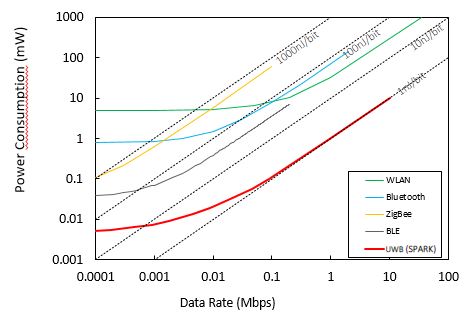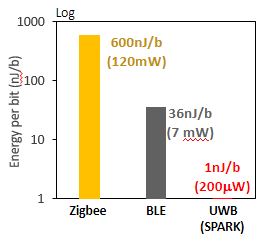This 6-article series started by asking the question: Why did Apple leap ahead of demand in 2019 by designing a UWB transceiver into the iPhone 11? Then in early 2020, why was UWB chip supplier Decawave acquired for an estimated $400-$500 Million? Why are automakers GM, Ford, Toyota, Nissan, Honda, Hyundai, Volkswagen, BMW and Mercedes all investing in UWB?
The answer is now clear: UWB offers a unique combination of accurate positioning, ultra-low power, ultra-low latency and high bandwidth that cannot be matched by any other short-range wireless technology. UWB deployments in 2021 have focused on precise positioning and location-based services: secure keyless entry, hands-free payments and indoor navigation. Coming soon are low-power and battery-free data IoT networks with up to 10X the bandwidth of Bluetooth.
This last article in the UWB series focuses on UWB’s superpowers as we enter the extreme-low-power and battery-free era.
UWB’s Superpowers: A Chronology
In the first five articles in this series, we examined the 100-year history of UWB and the development of each of its superpowers:
1912: Titanic uses wideband (WB) spark gap transmitters to call for help; all commercial ships are subsequently required to be equipped with WB transmitters and receivers are monitored 24/7. Spark gap transmitters took advantage of the first of wideband’s superpowers: using a wide spectrum to achieve a wideband signal.
1920s: Narrowband displaces WB in communications to serve the booming demand for code and voice channels.
1930s-1940s: Secret military research continues into wideband for its ranging capabilities, resulting in the RADAR revolution during World War II. RADAR takes full advantage of the second UWB superpower: high-precision positioning and ranging.
1980s-2000s: Medical imaging; ground, wall and foliage penetrating radars and synthetic aperture radar (SAR) take advantage of ultra-wideband’s high-precision imaging.
Early 2000s: Worldwide frequency allocations approved for UWB, but orthogonal frequency-division multiplexing (OFDM) UWB achieves limited deployment and mostly fails due to WiFi advances. Building on this experience, SPARK Microsystems develops a proprietary third UWB superpower: technology to make low-power low-latency UWB resilient to narrowband interference.
Early 2020s: Apple and automakers start shipping hundreds of millions of UWB transceivers for secure keyless entry and location-based services. These applications take full advantage of UWB’s superpower of accurate positioning. In parallel, SPARK Microsystems starts to present ultra-low latency audio and video links leveraging its UWB technology, showing off UWB’s fourth superpower: extreme low latency for interactivity.
UWB Smashes Through Bluetooth Design Limitations
Bluetooth has been wildly successful serving low-bandwidth, low-fidelity communications (wireless headsets and earbuds, for example). So why did Apple design yet another transceiver into the iPhone 11? To serve emerging applications that dramatically exceed Bluetooth’s design limitations, notably accurate positioning.
In Part 5 of this series, we explored how narrowband protocols like Bluetooth have fundamental limitations that make them less suitable than UWB for extremely low power, low latency and battery-less applications:
Data rate limits: The Bluetooth specification limits over the air bandwidth to just 3 Mbps, and in most system is limited to less than 1 Mbps. UWB can operate at tens of Mbps.
Low data rate power: Oscillator overhead and long packet duration keeps Bluetooth minimum power at several milliwatts for even at lowest data rates. UWB tailored to low power operation and to data streaming, as achieved with SPARK Microsystems’ implementation, can transmit 1 kbps at under 10 μW, making possible battery-free sensors powered by energy harvesting.
Latency: Bluetooth latency often exceeds 100 ms, which is noticed by headset users as echoes, long audio delays and speaking over each other on phone calls. This latency makes Bluetooth unattractive for interactive applications like game controllers and AR/VR, and unacceptable for industrial sensor and control systems. UWB offers sub-millisecond latency for near-real-time machine control and interactive entertainment systems.
Positioning: Location services and precise positioning are well-known strong points of UWB, which can measure relative locations within 10 cm accuracy. This is out of the reach of Bluetooth which struggles getting sub few meters accuracy.
Interference robustness: The 3-10 GHz band is becoming crowded. In addition to LTE, 5G and WiFi, including the recently announced WiFi 6E, all occupy different parts of this spectrum. It is possible to achieve robust UWB communications but this has to be done carefully in order to operate without impeding all of the other carrier-based signals, and effectively rejecting them. SPARK Microsystems’ UWB transceiver implementation has demonstrated robust operation with these interferers while providing robust data communications in the UWB spectrum.
UWB Ideal for Short-Range, Extreme Low-Power Applications:
Indeed, for short-range, low-power applications, UWB is superior to WLAN and Zigbee as well as classic Bluetooth and BLE:

The Bottom Line: Energy Consumed for a Complete Link
This chart compares the energy efficiency for a complete link at 200kbps for Zigbee, BLE and UWB:
Energy efficiency for complete link (200kbps)

When you add up all the power required to energize and stabilize the carrier frequency and transmit narrowband data, the total is 1-2 orders of magnitude greater than UWB when tailored to operate at low power.
Conclusion:
Today’s UWB doesn’t resemble its spark gap predecessors from 100 years ago. And although narrowband radios have dominated communications since the demise of the spark gap almost a century ago, UWB is at the beginning of a massive resurgence. After all, it is the first new unlicensed-spectrum wireless technology to be included into smartphones in about 20 years and other phone manufacturers have followed Apple’s lead. UWB’s ‘superpowers’ directly address the power, bandwidth and latency demands of new applications that narrowband cannot deliver. UWB is uniquely suited to dominate many emerging low-power, low-latency, higher data rate applications and pave the way toward battery-less applications.
Our sincere thanks to SemiWiki for giving us the opportunity to recap and share the history of UWB to date. It goes without saying that there is much more history still to be written! Be sure to ‘watch this space’ for subsequent entries detailing UWB’s many technologies and commercial milestones on the path to mainstream adoption.
About Frederic Nabki
Dr. Frederic Nabki is cofounder and CTO of SPARK Microsystems, a wireless start-up bringing a new ultra low-power and low-latency UWB wireless connectivity technology to the market. He directs the technological innovations that SPARK Microsystems is introducing to market. He has 18 years of experience in research and development of RFICs and MEMS. He obtained his Ph.D. in Electrical Engineering from McGill University in 2010. Dr. Nabki has contributed to setting the direction of the technological roadmap for start-up companies, coordinated the development of advanced technologies and participated in product development efforts. His technical expertise includes analog, RF, and mixed-signal integrated circuits and MEMS sensors and actuators. He is a professor of electrical engineering at the École de Technologie Supérieure in Montreal, Canada. He has published several scientific publications, and he holds multiple patents on novel devices and technologies touching on microsystems and integrated circuits.
About Dominic Deslandes
Dr. Dominic Deslandes is cofounder and CSO of SPARK Microsystems, a wireless start-up bringing a new ultra low-power and low-latency UWB wireless connectivity technology to the market. He leads SPARK Microsystems’s long-term technology vision. Dominic has 21 years of experience in the design of RF systems. In the course of his career, he managed several research and development projects in the field of antenna design, RF system integration and interconnections, sensor networks and UWB communication systems. He has collaborated with several companies to develop innovative solutions for microwave sub-systems. Dr. Deslandes holds a doctorate in electrical engineering and a Master of Science in electrical engineering for Ecole Polytechnique of Montreal, where his research focused on high frequency system integration. He is a professor of electrical engineering at the École de Technologie Supérieure in Montreal, Canada.
Share this post via:





Flynn Was Right: How a 2003 Warning Foretold Today’s Architectural Pivot